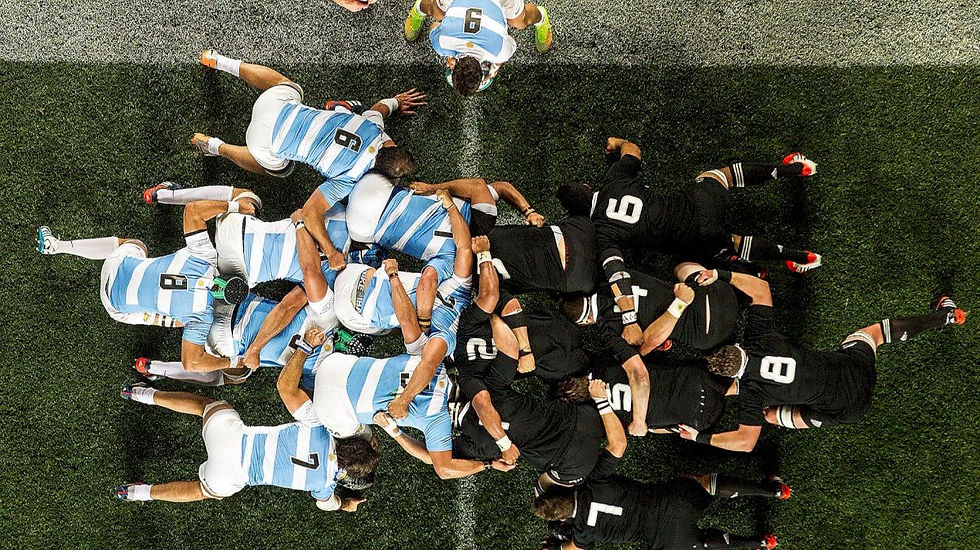A Beginner’s Guide to Watching Rugby
- Kyle Park

- Feb 27, 2021
- 4 min read
Rugby is often described as a mortal’s Clash of the Titans. While you may grimace at the brutal tackles that are common occurrences, you might get slightly confused about what’s going on in a rugby match. For example, you might wonder why the game stops so regularly, why players line themselves up in a diagonal formation, and what in the world a scrum is. As someone who was once a rugby novice, I feel your pain. I’ve always enjoyed rugby itself, but I’ve slowly become one of those rather annoying people who refer to technical rugby terminology in casual conversation. In all seriousness, once you finish reading this, you’ll realize that rugby is a lot simpler than you think.
The Basics
There are two major types of rugby: rugby league and rugby union (each has its own World Cup tournament). The main difference between league and union is the number of players (13 players and 15 players on each side for League and Union, respectively) on the field and the scoring policies. Thus, the two types of rugby share more similarities than differences.
The aim of rugby is to carry the ball over the opponent’s goal line and force it to the ground to score. Yet, there’s a catch. To go forward, a player can only pass backward. If a pass has gone forwards, the game is stopped, and the referee awards the opposition with a scrum (which we’ll get to in a second). In other words, all passes have to be thrown sideways or backward to a teammate: This is why you’ll see the attacking team position itself in a diagonal line for more effective play. Another way to move the ball forward is by kicking the ball towards the opposition’s goal line while making sure that the remaining teammates are behind the ball when the ball is kicked; if not, the play is offside––a penalty given when a player is further forward than the teammate who is carrying the ball or last played the ball. Being in an offside position itself is not an offense, but an offside player cannot take part until he or she is onside again. If none of the aforementioned options interest you, simply running with the ball after deking the opponent with a classic rugby step is another offensive option.
Scoring is another confusing part of the game, as there are four ways a player can score points in rugby. The most common way is the try (union: five points, league: four points), which is scored when the ball makes contact with the ground over the opponent’s goal line. A penalty try (union: five points, league: three points) can also be awarded if a player would have scored but was denied by a foul play by the opposition. Following a try, teams have a chance for a conversion (two points) by kicking the ball over the crossbar from the spot in line where the try was scored; hence, rugby players run towards the center of the goal zone to make it easier for the kicker to score a conversion. A player can also drop the ball onto the ground and kick it over the crossbar during an open play for a drop goal (union: three points, league: two points). Similarly, a team can choose to kick at goal for three points if a penalty is awarded after an infringement by the opposition.
The Controversial Scrum
A scrum is a method for restarting the play when there is a rule violation involving players packing closely together while interlocking their heads in an attempt to win possession. The nature of the scrum forces players to endure immense pressure, frequently injuring athletes when a scrum collapses. Moreover, while scrummaging has been an integral part of rugby tradition, it often makes the game repetitive to watch when a scrum consecutively fails multiple times. Hence, the International Rugby Board has considered modifying its scrum policies; many have proposed the idea of awarding the team in possession with a tap and go when a scrum collapses for the second time in a row. This way, scrums won’t take up a large portion of the game, allowing for more action time. This age-old debate vis-à-vis the necessity of scrums continues, and a definitive solution in the near future seems unrealistic.
Richie McCaw: A Name to Remember
What do you get when you cross a player with a monster physique and a player with lightning speed? Richie McCaw. Though rugby continues to foster young talents and rising superstars, the sport is no stranger to legends like New Zealand rugby union player Richie McCaw, often referred to as ‘King Richie’. Playing for the three-time world champion All Blacks, New Zealand’s national rugby union team, he has built an impressive career and displays the qualities of an elite athlete.
Hall of Famer McCaw has carved out a formidable reputation as arguably the greatest openside flanker, a player who wins possession of the ball through turnovers. With a total of 135 points and 131 wins with the All Blacks, McCaw added 10 rugby championships to his trophy cabinet. Though, what makes McCaw different from the rest is his ambitious and committed mindset. Throughout his career, McCaw suffered knee fractures, concussions, and multiple foot injuries; notably, a stress fracture in his right foot greatly limited McCaw’s 2011 season. His playing time was strictly limited due to past surgeries and was unable to contribute to the team’s performance. Without McCaw, the All Blacks failed to defend the championship against South Africa. Yet the following year, McCaw fully recovered and led the team to three consecutive Tri-Nations Series titles––the sign of a true fighter.
So, the next time you come across a rugby match on TV, don’t skip the channel assuming you won’t understand. Instead, be patient and allow yourself to witness the beauty behind rugby.






Comments